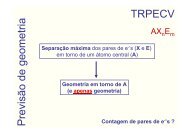Jorge Manuel de Oliveira Vicente Tese de Mestrado em Engenharia ...
Jorge Manuel de Oliveira Vicente Tese de Mestrado em Engenharia ...
Jorge Manuel de Oliveira Vicente Tese de Mestrado em Engenharia ...
You also want an ePaper? Increase the reach of your titles
YUMPU automatically turns print PDFs into web optimized ePapers that Google loves.
processes, is in a period of rapid growth and will fundamentally change the way computing<br />
power is applied in organizations.<br />
Whereas BPM has already <strong>de</strong>livered consi<strong>de</strong>rable value in many companies, the<br />
components of the full BPM solution are still evolving and are the subject of ongoing research<br />
and <strong>de</strong>velopment [10].<br />
Business Process Manag<strong>em</strong>ent is an old discipline that allows you to mo<strong>de</strong>l the<br />
organizational structure, <strong>de</strong>fine the business processes, and show the interactions between<br />
th<strong>em</strong>, from <strong>de</strong>sign to automation.<br />
The whole point of automating business processes is to improve operations—in cost, time,<br />
or quality. Once a process has been <strong>de</strong>veloped and <strong>de</strong>ployed, how can we know if it is meeting<br />
the inten<strong>de</strong>d goals? We know how to instrument IT syst<strong>em</strong>s and monitor th<strong>em</strong> with a high<br />
<strong>de</strong>gree of precision. These statistics, however, do not generally provi<strong>de</strong> a business-process<br />
context around this information. The challenge is to aggregate and present execution data at<br />
the business-process level. Gartner coined the term business activity monitoring (BAM) for this<br />
capability. It <strong>de</strong>fines BAM as providing “real-time access to critical business performance<br />
indicators to improve the speed and effectiveness of business operations.<br />
Without BAM, operational managers have no way of <strong>de</strong>termining whether the processes for<br />
which they are responsible are meeting their objectives [11].<br />
1.4. Summary<br />
Today a business process has some activities that have one or more service that fully<br />
supports th<strong>em</strong>. If that service stops and we ask to the operational manager why, consulting a<br />
BAM dashboard it’s possible that he can i<strong>de</strong>ntify the reason “pointing the finger” to the Service<br />
Manager. At the other si<strong>de</strong>, the service manager and the Business Support team work in the<br />
way to solve the inci<strong>de</strong>nt, and in the end, service manager congratulates himself and his team<br />
because they solve the inci<strong>de</strong>nt rapidly maintaining the performance, but is operational<br />
manager satisfied?<br />
Thus, we have two types of indicators that are sensible to an inci<strong>de</strong>nt: the business-level<br />
and the service-level. But are they aligned? What is the cost of that service to both managers?<br />
What is the cost to the business when a service stops?<br />
Normally we encounter 2 different visions (1) focus on the business processes (2) focus on<br />
the services. Regardless the business goals, it’s possible that the BPM and ITSM aren’t aligned.<br />
Figure 4 shows the different views between business and services. A manager has a view<br />
concerned with business and with the objective to maintain business running no matter what<br />
5

















